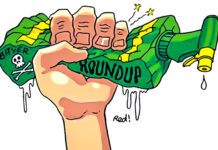The National Action Plan (NAP) for the sustainable use of pesticides is 3 years behind schedule but the European Commission does not bat an eye, having approved the NRP where funds for ‘sustainable agriculture‘ are earmarked for photovoltaic panels, logistics and mechanization.
As is often the case in Italy-when it comes to agriculture, the environment and health, the right goes backwards. The ‘ecological transition’ does not even touch on the issues of biodiversity and protection of soils, water and atmosphere from agrochemicals. All thanks to Coldiretti’s leader of leaders? #Clean Spades, #NextGenerationEU.
1) NAP, national action plan for the sustainable use of pesticides.
1.1) 2019, the Italian shame
Dir. 2009/128/EC requires each member state to develop a national action plan on the sustainable use of pesticides and provide for its review at least every five years (Article 4). Italy implemented the directive by Legislative Decree. 150/12 and published its unique and unchanged NAP pesticides on 1/22/14.
7/18/19 the ministries of Agriculture, Environment and Health-evidently succubi of Coldiretti and the agricultural confederations in its wake-had published a shameful outline of a ‘National Action Plan for the Sustainable Use of Pesticides,’ where a ‘minimum safe distance’ of 5 meters from homes, schools and hospitals was stipulated. No distance with a meter-high hedge.
1.2) 2019-2022, three years late
On 4.10.19, the above ministries convened the relevant social partners. Not only the conniving col-diretti but also associations such as ISDE (Physicians for the Environment), as well as the No Pesticides group and the Égalité association humbly represented by the writer. (1)
The NAP of Shame was thus withdrawn before its adoption that would be followed by legal action to protect public health-that of children first and foremost-from the risks associated with exposure to agrotoxics. Since then, however, nothing has happened.
2) Strasbourg-Brussels, back-and-forth.
2.1) European Parliament, the question.
Eleonora Evi, MEP spokesperson for the Green Europe Group, submitted a question on the subject to the European Commission on 8.12.21. After pointing out that as of 2019 Italy ‘has not published any new national action plan and there is no information on the timing of such publication,’ Eleonora Evi asked some simple questions:
‘1. Is the Commission aware of the significant delay in the revision of the Italian National Action Plan?
2. Does this delay violate Article 4 of Directive 2009/128/EC?
3. What actions will the Commission take to expedite the review of the Italian National Action Plan?‘ (2)
2.2) European Commission, laconic response
On 25.1.22 Commissioner Stella Kyriakides provided Hon. Eleonora Evi with the laconic response (3) below:
– 1-10.3.21 the European Commission’s Food and Veterinary Office (FVO) conducted an audit to assess Italy’s implementation of Directive 2009/128/EC (4,5,6). Actually experiencing the delay reported above,
– ‘Todate, Italian authorities have not yet submitted a revised national action plan to the Commission.
Both the delay in adopting the initial national action plan and the persistent delay in adopting the revised national action plan constitute violations of Article 4 of Directive 2009/128/EC.’
2.3) The starvation of the Commission.
‘The aforementioned audit report made several recommendations to Italian authorities, including that the national action plan be reviewed at least every five years.
The Commission will continue to monitor this matter by urging the Italian authorities to ensure that all recommendations made in the audit report are implemented in a timely and effective manner’. (3)
3) Agriculture and sustainability in Italy
3.1) ImPANtanates
The Italian authorities, in their response to the Food and Veterinary Office, (5) stated the following:
– the new NAP would be ‘in the process of definition and approval‘. Really, when? And where is its draft, to be submitted for consultation with interested social partners?
– ‘with regard to thequality of water intended for human consumption (…) the results of the controls carried out in the last three-year reporting period 2017-2019 (…) did not show non-compliance regarding the presence of active substances of plant protection products‘. False. In contrast, the ISPRA 2020 report indicates agrotoxin concentrations above environmental limits in 21 percent of surface waters (415 monitoring points) and 5.2 percent of groundwater (146 points). (7)
3.2) Sustainable agriculture and NRP
Italy also stated that the quantitative targets of the new NAP ‘predict both a substantial increase in areas conducted with low-impact production methods of plant protection products (including a 60 percent increase in organic acreage and 30 percent increase in certified integrated production – SQNPI), as well as reducing sales of certain categories of particularly hazardous active substances (candidates for substitution, hazardous, and priority hazardous)‘. (5)
The NRP, however-as highlighted in the valuable analysis by Francesca Coli and Antonio Manzoni of the Scuola Superiore Sant’Anna (10)-does not include any funding for biodiversity in measure M2C1(Sustainable Agriculture), although €2.80 billion is dedicated to it. To which is added €1.2 billion from the Supplementary Fund to the NRP to finance ‘supply chain and district contracts for the agri-food, fisheries and aquaculture, forestry, floriculture and nursery sectors‘.
3.3) NRP, resources taken away from biodiversity and ecosystem protection.
€2.8 billion earmarked for ‘sustainable agriculture’ in the M2C1 measure of the NRP is dedicated to three areas of investment:
– agrisolar park, € 1.5 bn. Funding for the installation of photovoltaic panels on the roofs of farm facilities. Growing energy on rooftops, guaranteed water and energy savings. What about agriculture?
– logistics, €0.8 billion. Reduce the environmental impact of the transportation system in the agribusiness sector, improve storage capacity, enhance the export capabilities of Italian agribusiness SMEs, and ensure product traceability. What about sustainability of agronomic practices?
– innovation and mechanization, € 0.50 bn. Electric tractors, sensors and drones? The idea of automatic mechanical weeding instead of chemical weeding is not bad, but it is only one of many possible innovations whose funding is not contingent on converting crops to organic, nor on other benefits to biodiversity, nor on protecting soils, water, air, health.
4) #CleanSpades.
‘The Recovery Plan and our plans for a decisive turn of agriculture toward the green revolution: the ecological transition and digital (digitization of the countryside; urban forests to mitigate pollution and smog in cities, inland water reservoirs to save water, green chemistry, bioenergy to combat climate change‘ (Vincenzo Gesmundo, report 25.3.21).
The boss of bosses – ‘the one who commands everything‘ and everyone at his baton, ministers and prime ministers of all colors – a year ago declared to his hierarchies: ‘at the moment we still do not know the fate of the six projects contained in the Recovery Plan, which in essence are signed at the bottom of the page by Coldiretti. (…) Because when Coldiretti does Coldiretti there is none for anyone!‘. Not even for the ecological transition, precisely.
5) #NextGenerationEU
The Recovery Plan has been correctly renamed the Next Generation EU, as the trillion-dollar public debt and stability conditions that will follow it with the ESM fall on the next generation.
Instead, the measures on ‘sustainable agriculture’ adopted in the NRP continue to fatten the Old Generation EU without bringing any benefit to the resilience that is associated with healthy soils, waters and ecosystems.
On the other hand, one cannot imagine that today’s farmers and ranchers in the doldrums, with skyrocketing production costs and stagnant prices, can cope with the ecological transition at their own expense. The time has come for a change of course.
Dario Dongo
Notes
(1) Dario Dongo. Pesticides, the danger of Peter Pan. Égalité. 5.10.19, https://www.egalite.org/pesticidi-il-pericolo-di-peter-pan/
(2) European Parliament. Question 8.12.21 Hon. Eleonora Evi (Verts/ALE Group) to the Commission. E-005470/2021. https://www.europarl.europa.eu/doceo/document/E-9-2021-005470_IT.html
(3) Answer 25.1.22 by Stella Kyriakides on behalf of the European Commission to Question E-005470/2021.
https://www.europarl.europa.eu/doceo/document/E-9-2021-005470-ASW_IT.html
(4) Food and Veterinary Office (FVO). Final report of the audit of Italy of the audit of Italy from 1 to 10.3.21 in order to assess the implementation of measures to achieve the sustainable use of pesticides and aspects of the authorization of plant protection products. DG(SANTE) 2021-7298. https://ec.europa.eu/food/audits-analysis/act_getPDF.cfm?PDF_ID=15481
(5) Response of the competent authorities Italian authorities to the recommendations of DG (SANTE) 2021-7298. https://ec.europa.eu/food/audits-analysis/act_getPDFannx.cfm?ANX_ID=10086
(6) Directive 2009/128/EC establishing a framework for Community action to achieve the sustainable use of pesticides. Consolidated version as of 7/26/19 at https://bit.ly/3AYFN4R
(7) Dario Dongo. ISPRA, 2020 report on pesticides in water. GIFT(Great Italian Food Trade). 12/24/20, https://www.greatitalianfoodtrade.it/sicurezza/ispra-rapporto-2020-sui-pesticidi-nelle-acque
(8) Francesca Coli, Antonio Manzoni. Green revolution and agri-food: the PNRR strategy between European and national needs. Pandora Magazine. 12/20/21, https://www.pandorarivista.it/articoli/green-revolution-e-agri-food-la-strategia-del-pnrr-tra-esigenze-europee-e-nazionali/
Dario Dongo, lawyer and journalist, PhD in international food law, founder of WIISE (FARE - GIFT - Food Times) and Égalité.








